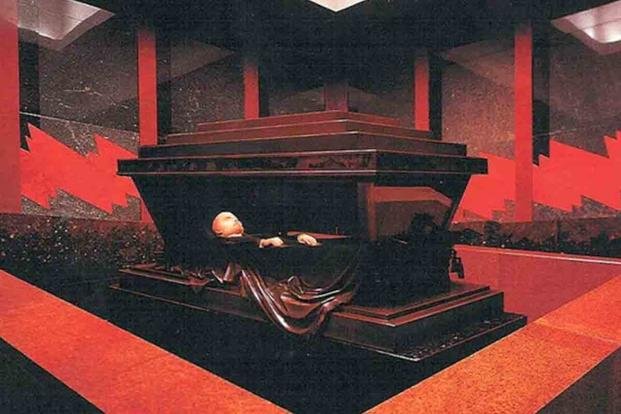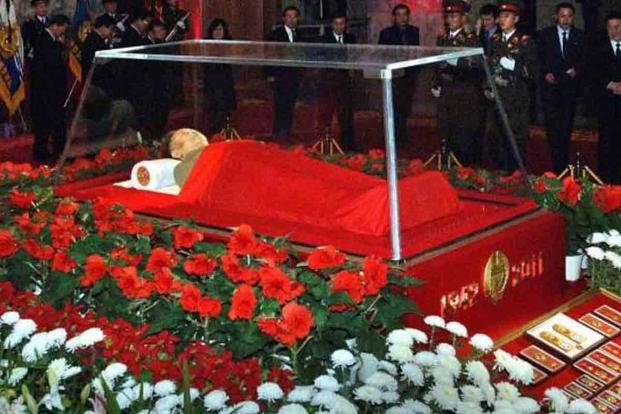For some reason, communist regimes around the world just can't seem to let go of their old leadership. For most, it's enough to have their dead, embalmed bodies encased in glass and on display in perpetuity. North Korea, however, passed a resolution to keep one of its dead men in glass as president for all eternity.
It's not an official tradition, but the founders of new regimes who did not outlive their communist governments have ended up this way since the very beginning of communism, with the notable exception of Fidel Castro. These five are still embalmed and still open for visits -- with varying degrees of difficulty.
1. Vladimir Lenin
The original embalmed communist, no one affected the future of Russia or the world as much as Vladimir Ilyich Ulyanov, also known as Lenin. Unfortunately for the Russian revolutionary, his strokes were the only things outside of his control. His second stroke left his right side paralyzed. After his third stroke in 1923, he could no longer speak.
On Jan. 21, 1924, Lenin slipped into a coma and died. His remains were taken to Moscow, where he would be interred in a special glass mausoleum forever, his body permanently embalmed for display adjacent to Red Square. Lenin's Mausoleum is still there today.

2. Ho Chi Minh
By the time the Vietnam War began for the United States, Ho Chi Minh was in his 70s. The former guerrilla fighter against the Japanese occupation of Vietnam may have admired American ideals, but he was a committed communist. When he died of a heart attack in 1969, North Vietnam was still teetering on the edge of losing the war to the South and its American backers.
Construction on the Ho Chi Minh Mausoleum began in September 1973, after the U.S. had withdrawn its troops from Vietnam, and was formally dedicated in August 1975, after the two Vietnams were reunited by force. For the six years between his death and the mausoleum's construction, his body was moved constantly to protect it. His embalmed remains are in a glass case in the center, protected by an honor guard.
3. Mao Zedong
Chairman Mao was a physical wreck for the last few years of his life, with chronic lung and heart problems and possibly even Parkinson's disease and Lou Gehrig's disease. With the secretive nature of communist regimes, it's anyone's guess. What we do know is that he finally succumbed to his third heart attack in 1976.
After lying in state for a week, his body was embalmed (against his wishes) and placed in what would soon become the Chairman Mao Memorial Hall off of Tiananmen Square. The project was begun right after his death in September 1976 and was completed in May 1977, with the help of 700,000 people. Like Lenin and Ho Chi Minh before him, his embalmed remains are in a cooled glass case inside.
4. Kim Il-Sung
North Korea's founder and Eternal President died of a sudden heart attack in 1994 after ruling the country for 46 years, sparking one of the deadliest conflicts in modern history, and creating a paranoid rogue state still best known for the Kim cult of personality. After a 10-day mourning period, his remains were taken to Kumsusan Palace of the Sun.
Unlike the other dictators, the Kumsusan Palace was not built for the purpose of housing the "Great Leader's" dead body. It was built to house his living one. It was converted to a mausoleum after his death. His body remains encased in glass in the house, positioned so visitors can't see the giant goiter on his neck.
5. Kim Jong-Il
Like father, like son ... at least in death. Unlike his father's reign, Kim Jong-Il's rule was marked by turbulence, famine and deprivation. Like his father, however, he died from a massive heart attack. His time came in December 2011, and following a mourning period, a 232-member funeral procession carried his embalmed remains to Kumsusan Palace of the Sun.

Kim Jong-Il's body got its own sarcophagus room, complete with glass casing, where his body rests much the way his father's does. It's different in that viewers can also see his Macbook, personal yacht and the train on which he had the heart attack that killed him.
-- Blake Stilwell can be reached at blake.stilwell@military.com. He can also be found on Twitter @blakestilwell or on Facebook.
Want to Learn More About Military Life?
Whether you're thinking of joining the military, looking for post-military careers or keeping up with military life and benefits, Military.com has you covered. Subscribe to Military.com to have military news, updates and resources delivered directly to your inbox.
















